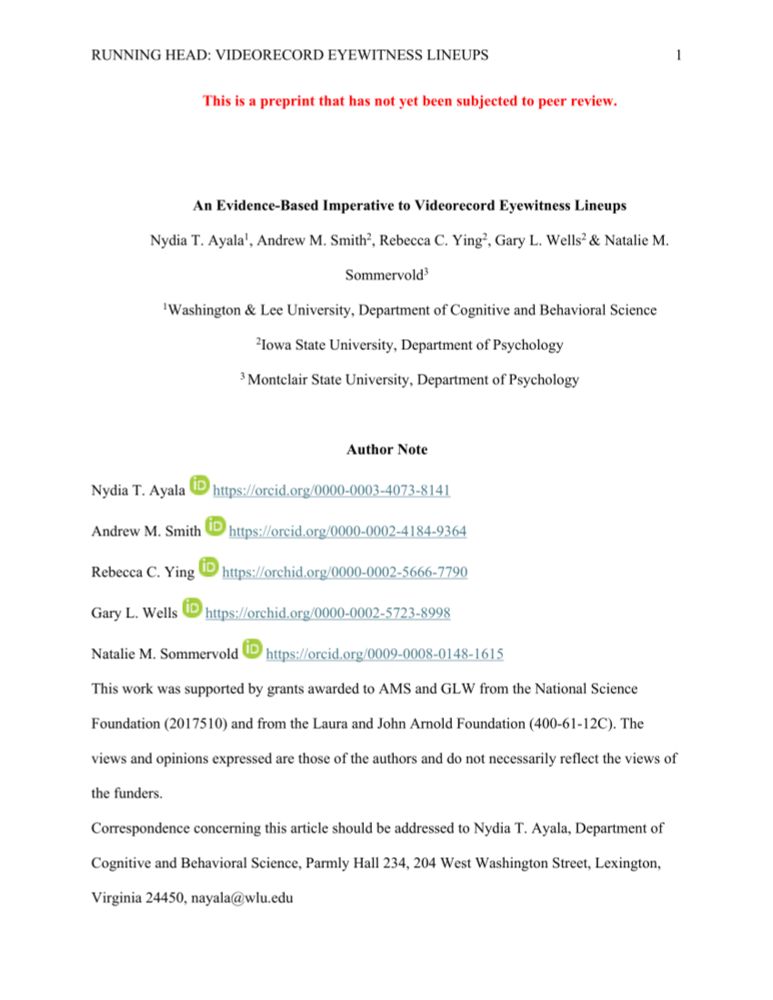Nydia Ayala
@nydia-ayala.bsky.social
390 followers
28 following
16 posts
Assist. Prof. of Cognitive & Behavioral Science @ W&L | Eyewitness Researcher
Posts
Media
Videos
Starter Packs
Reposted by Nydia Ayala
Nydia Ayala
@nydia-ayala.bsky.social
· Jul 30
Rebecca Ying
@rying.bsky.social
· Jul 29

(PDF) The Rejection-Inferiority Effect: Why are Eyewitness Lineups More Effective at Demonstrating Guilt than Innocence?
PDF | Experimental research on eyewitness lineups demonstrates a rejection-inferiority effect: the inculpatory value of lineups exceeds the exculpatory... | Find, read and cite all the research you ne...
www.researchgate.net
Nydia Ayala
@nydia-ayala.bsky.social
· Jul 29
Nydia Ayala
@nydia-ayala.bsky.social
· Jul 29

(PDF) An Evidence-Based Imperative to Videorecord Eyewitness Lineups
PDF | In a large-scale, high-impact experiment (N = 1,496), we videorecorded witness-participants as they completed lineup procedures in the presence of... | Find, read and cite all the research you n...
www.researchgate.net
Nydia Ayala
@nydia-ayala.bsky.social
· Jul 29
Nydia Ayala
@nydia-ayala.bsky.social
· Jul 29
Nydia Ayala
@nydia-ayala.bsky.social
· Jul 29
Nydia Ayala
@nydia-ayala.bsky.social
· Jul 29
Nydia Ayala
@nydia-ayala.bsky.social
· Jul 29
Nydia Ayala
@nydia-ayala.bsky.social
· Mar 9
Nydia Ayala
@nydia-ayala.bsky.social
· Mar 9
Nydia Ayala
@nydia-ayala.bsky.social
· Mar 9
Nydia Ayala
@nydia-ayala.bsky.social
· Mar 9

(PDF) Beyond the Confidence-Accuracy Relation: A Multiple-Reflector-Variable Approach to Postdicting Accuracy on Eyewitness Lineups
PDF | We examined whether the potential to distinguish between accurate and inaccurate decisions on eyewitness lineups could be improved by combining... | Find, read and cite all the research you need...
www.researchgate.net
Reposted by Nydia Ayala
Nydia Ayala
@nydia-ayala.bsky.social
· Jan 10

Using Artificial Intelligence to Assess Eyewitness Identification Accuracy | Request PDF
Request PDF | Using Artificial Intelligence to Assess Eyewitness Identification Accuracy | Drawing on recent experimental research, we propose three ways in which artificial intelligence (AI) can be u...
www.researchgate.net
Nydia Ayala
@nydia-ayala.bsky.social
· Jan 10
Reposted by Nydia Ayala
Rebecca Ying
@rying.bsky.social
· Nov 20

(PDF) Perceptions of Task Fluency Mislead Judgments of Eyewitness Identification Accuracy
PDF | Eyewitness identifications from lineups in which the suspect stands out (biased lineups) are less reliable than identifications from lineups in... | Find, read and cite all the research you need...
www.researchgate.net
Nydia Ayala
@nydia-ayala.bsky.social
· Sep 17
Reposted by Nydia Ayala
Rebecca Ying
@rying.bsky.social
· Sep 16





